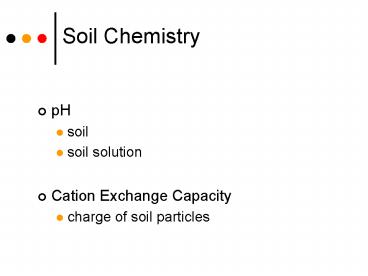Soil Chemistry - PowerPoint PPT Presentation
1 / 21
Title:
Soil Chemistry
Description:
soils in in regions of high rainfall tend to be acid. Cations ... Boron. Molybdenum. Chlorine. Nickel. Remember 17. C. Hopkins Caf Managed by my cousin Mocel ... – PowerPoint PPT presentation
Number of Views:4826
Avg rating:3.0/5.0
Title: Soil Chemistry
1
Soil Chemistry
- pH
- soil
- soil solution
- Cation Exchange Capacity
- charge of soil particles
2
Soil pH
- Measure of Hydrogen ion activity
- Acidic-Neutral-Alkaline
- determines availability of nutrients
- buffering - soil resist sudden large changes in pH
3
pH Range
- Note this a
- Logarithmic Scale based on the
- "powers of ten"
- pH 6.0 is 10-times more acidic than pH 7.0
- pH 5.0 is 100-times more acidic than pH 7.0
- 6.5-7.2 is ideal
4
Acidic Soil
- soils in in regions of high rainfall tend to be
acid - Cations leach according to strength held
- HgtCagtMggtKgtNH4gtNa
- as cations are leached from soil solution,
cations on soil particles move into soil solution
- H replaces these cations on the soil particle
- pH of soil decreases - becomes more acidic
5
Acidic Soil
- add acid forming materials to soil to amend pH
- peat moss, pine needles
- elemental sulfur, sulfate fertilizers
- form H2SO4 - increase H concentration
6
Alkaline Soil
- increase soil pH with lime (CaCO3)
- in soil solution Ca and OH- (hydroxyl ion)
- Increased Ca concentration displaces H
- H interacts with OH in soil solution
- pH increases - becomes more alkaline
7
Cation Exchange Capacity
- Clay and organic matter have a negative charge
- attract and hold cations
- Cations are attracted/held with different
strength - HgtCagtMggtKgtNH4gtNa
- soluble salts - amount of cation salts in soil
solution
8
Plant Nutritional Requirements
- Depend on
- plant/crop characteristics
- rate of growth - light temperature
- stage of development
- flower, fruiting, rooting
- growing medium - CEC
- amount of rainfall/irrigation
- temperature
- container size - limited reservoir
9
Essential Elements for Plants
- Iron
- Manganese
- Zinc
- Copper
- Boron
- Molybdenum
- Chlorine
- Nickel
- Carbon
- Oxygen
- Hydrogen
- Nitrogen
- Phosphorus
- Potassium
- Calcium
- Magnesium
- Sulfur
10
Remember 17
- C. Hopkins Café Managed by my cousin Mocel
- C H O P K N S Ca Fe Mg B Mn Cu Zn Mo Cl
For a Nickel
11
Nitrogen (N) pg 253
- Plants take up in form of
- NO3-(rarely), NO2-, NH4
- nitrate(NO3-) highly leachable
- Sources
- Ammonium, Nitrate, Urea
- Functions
- synthesis of amino acids, proteins, chlorophyll,
nucleic acids and coenzymes - Vegetative growth
12
Phosphorus (P)
- Plants take up as
- H2PO4- orthophosphorus (acid)
- HPO4- monohydrogen phosphate (alkaline)
- Source
- mined apatite (rock phosphate)
- decomposition of organic matter
13
Phosphorus
- Function
- energy (ATP, NADPH) metabolic transfer processes,
photosynthesis, respiration, nucleic acids
(genetic material), phospholipids (membranes) - early maturity (flowers and fruit), root growth,
stem strength
14
Potassium (K)
- Taken up in elemental form
- Source
- Potassium chloride, Potassium sulfate, potassium
nitrate - Function
- sugar and starch formation, synthesis of proteins
- enzyme reactions, osmotic regulation, stomatal
opening
15
Iron (Fe)
- Function
- chlorophyll synthesis, enzymes, photosynthesis
- Source
- soils
- ferrous sulfates
16
Chelating Agents
- large organic molecule that plant can absorb
- combine with cations to prevent them from
reacting with anions that would make them
insoluble and unavailable - combine with iron, manganese, zinc, copper
17
Determining Requirements
- controlled studies for crop and production
techniques - soil test - need to consider availability not
just presence - tissue analysis -
- tissue and when it is sampled varies for each crop
18
Nutrient availability
- Amount of nutrient in soil /soil solution
- Form of Nutrient
- Water availability
- pH
19
pH and Nutrient Uptake
20
Nutrient Deficiency
- Mobile N P K Cl Mg
- Immobile B Ca Cu Fe Mn Ni S Zn
- Chlorotic
- Interveinal
- Necrosis
- Stunting
- Handout
21
Photo Websites
- www.hbci.com/wenonah/min-def/list.htm
- http//hort.ufl.edu/nutdef

